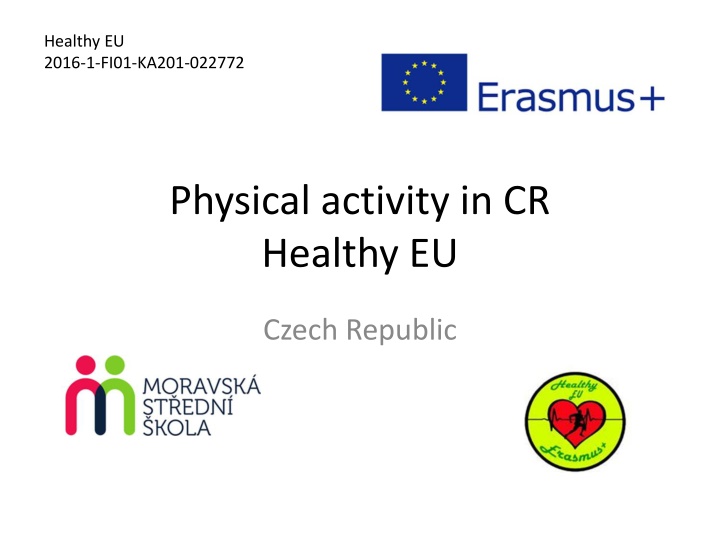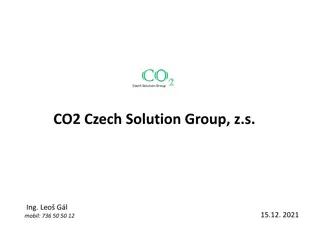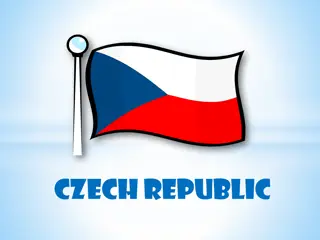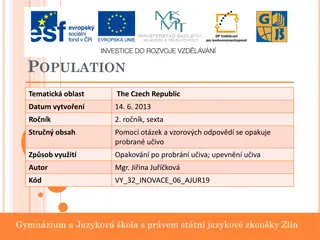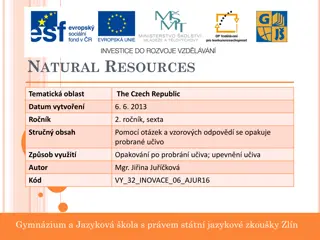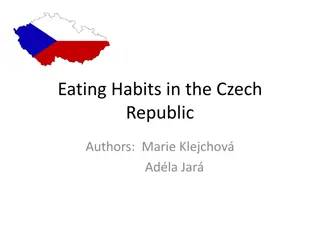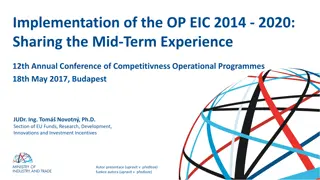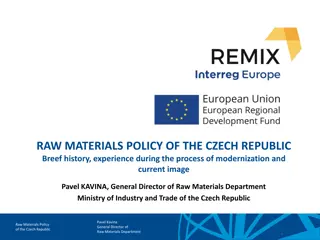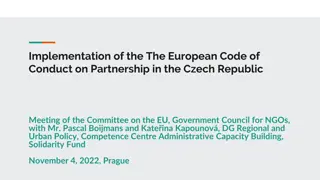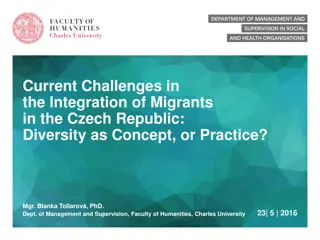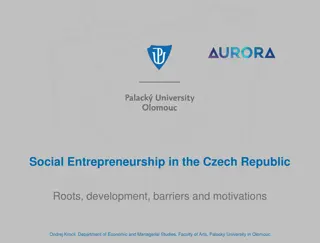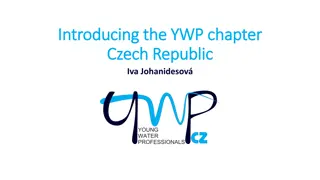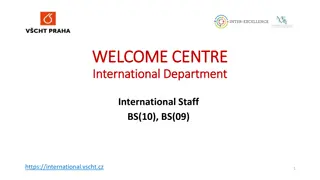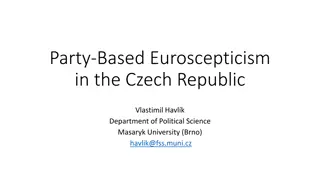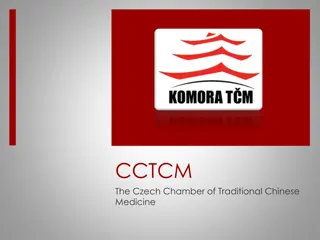Research Work for Physical Activity Statistics in the Czech Republic
The Czech Republic excels in measures of well-being but faces challenges in income and wealth distribution. Research in physical activity statistics focuses on various aspects like strength, speed, mobility, and mental well-being. Initiatives include assessing energy expenditure from basic activities and promoting physical activities among different populations. Studies also explore public attitudes towards sports and physical education. The country's performance in physical activity and sedentary behavior is monitored for public health improvement.
Download Presentation

Please find below an Image/Link to download the presentation.
The content on the website is provided AS IS for your information and personal use only. It may not be sold, licensed, or shared on other websites without obtaining consent from the author.If you encounter any issues during the download, it is possible that the publisher has removed the file from their server.
You are allowed to download the files provided on this website for personal or commercial use, subject to the condition that they are used lawfully. All files are the property of their respective owners.
The content on the website is provided AS IS for your information and personal use only. It may not be sold, licensed, or shared on other websites without obtaining consent from the author.
E N D
Presentation Transcript
Healthy EU 2016-1-FI01-KA201-022772 Physical activity in CR Healthy EU Czech Republic
Themes of Presentation Research work for physical activity statistics in your country. Strength endurance, Maximum strength, Speed, Mobility, Skill and technique, body management, Resistance exercise, strength training, mental training and coordination. How body works in different activities? How to motivate young to move? Different projects for this on your area? How to improve mental welfare through physical welfare? Physical education in your schools? Different surroundings on your area for sports?
Research work for physical activity statistics in CR The Czech Republic performs well in many measures of well-being in the Better Life Index. The Czech Republic ranks above average in personal security, education and skills, social connections, subjective well-being, and work-life balance. It ranks below average in jobs and earnings, housing, health status, income and wealth, and civic engagement. Money, while it cannot buy happiness, is an important means to achieving higher living standards. In the Czech Republic, the average household net-adjusted disposable income per capita is USD 18 953 a year, less than the OECD average of USD 29 016 a year. But there is a considerable gap between the richest and poorest the top 20% of the population earn nearly four times as much as the bottom 20%.
Research work for physical activity statistics in CR BUNC, V. koln ml de ke konci 20. stolet . Zpr va v zkumn ho grantu. Praha: FTVS UK 1999. BUNC, V., TEPL , Z. Hodnocen energetick n ro nosti z kladn ch t lesn ch aktivit. as. L ka . es. 128, 1989, . 50., str.1580 1583. JANSA, P., KOCOUREK, J. Pohybov aktivity u dosp l populace v esk republice. In : Optim ln p soben t lesn z t e a v ivy . Hradec Kr lov : Univerzita 2001., str. 148 152. JANSA, P., KOCOUREK, J., K DOV , G. Sport a pohybov aktivity dosp l populace v esk republice 2001. In Konference T lesn v chovy, sport, v zkum na univerzit ch . Bratislava: STU KTV 2001., str. 102 108. JANSA, P. N zory (postoje) adolescentn ml de e na sport, t lesnou v chovu a jin pohybov aktivity. esk kinatropologie, 2002 ro . 6., . 2, s. 23 39. GUILFORD, J. P., FRUCHTER, B. Fundamental statistic in psychology and education. London: McGraw Hill 1987. NOVOTN et al. Kapacitn mo nosti sou asn struktury t lov chovn ch za zen v R.. V zkumn grant M MT. Praha : UK FTVS 1993. RYCHTECK , A. Monitorov n asti ve sportu a pohybov aktivit v esk republice a evropsk ch zem ch. Zpr va v zkumn ho grantu. Praha, UK FTVS 2000. SLEPI KA, P., SLEPI KOV , I. Sport v pohledu esk ve ejnosti I. esk kinantropologie. 6, 2002 .1. TEPL , Z. Pohybov re im dosp l ch. UK Praha, 1990. TEPL , Z. Zdrav , zdatnost a pohybov re im. Praha: es. Asoc. SPV, 1995. ZICH, F., UNGR, V. Postoje esk ve ejnosti k t lesn v chov a sportu. Ro . 61, TVSM, 1995., . 7 8 viz. P loha.
Physical activity and sedentary behaviour in Czech adults: Results from the GPAQ study https://www.ncbi.nlm.nih.gov/pmc/articles/PMC39352 22/ The levels of physical activity (PA) and sedentary behaviour are significant indicators of health behaviour and their monitoring is crucial in developing public policy in the area of health promotion and non- communicable disease prevention. The aim of the study was to describe the prevalence of PA and sedentary behaviour as well as age and gender differences in Czech adults (18 90 years old, N = 1753; 48.4% male) participating in the Global Physical Activity Questionnaire (GPAQ) cross-sectional study 2011.
Social determinants of health and well-being among young people. Health Behaviour in School-aged Children (HBSC) study: international report from the 2009/2010 survey http://hbsc.upol.cz/1-cestina/59-publikace/
Strength endurance, Maximum strength, Speed, Mobility, Skill and technique . Strength training is a type of physical exercise specializing in the use of resistance to induce muscular contraction which builds the strength, anaerobic endurance, and size of skeletal muscles. When properly performed, strength training can provide significant functional benefits and improvement in overall health and well-being, including increased bone, muscle, tendon and ligament strength and toughness, improved joint function, reduced potential for injury, increased bone density, increased metabolism, increased fitness, improved cardiac function, and improved lipoprotein lipid profiles, including elevated HDL ("good") cholesterol. Training commonly uses the technique of progressively increasing the force output of the muscle through incremental weight increases and uses a variety of exercises and types of equipment to target specific muscle groups. Strength training is primarily an anaerobic activity, although some proponents have adapted it to provide the benefits of aerobic exercise through circuit training. Sports where strength training is central are bodybuilding, weightlifting, powerlifting, strongman, Highland games, shotput, discus throw, and javelin throw. Many other sports use strength training as part of their training regimen, notably tennis,American football, wrestling, track and field, rowing, lacrosse, basketball, pole dancing, hockey, professional wrestling, rugby union, rugby league and soccer. Strength training for other sports and physical activities is becoming increasingly popular.
Strength endurance, Maximum strength, Speed, Mobility, Skill and technique . Physical exercises are generally grouped into three types, depending on the overall effect they have on the human body: Aerobic exercise is any physical activity that uses large muscle groups and causes the body to use more oxygen than it would while resting.The goal of aerobic exercise is to increase cardiovascular endurance. Examples of aerobic exercise include cycling, swimming, brisk walking, skipping rope, rowing, hiking, playing tennis, continuous training, and long slow distance training. Anaerobic exercise, which includes strength and resistance training, can firm, strengthen, and tone muscles, as well as improve bone strength, balance, and coordination. Examples of strength moves are push-ups, pull-ups, lunges, and bicep curls using dumbbells. Anaerobic exercise also include weight training, functional training, eccentric training, Interval training, sprinting, and high- intensity interval training increase short-term muscle strength. Flexibility exercises stretch and lengthen muscles. Activities such as stretching help to improve joint flexibility and keep muscles limber. The goal is to improve the range of motion which can reduce the chance of injury. Physical exercise can also include training that focuses on accuracy, agility, power, and speed. Sometimes the terms 'dynamic' and 'static' are used.[citation needed] 'Dynamic' exercises such as steady running, tend to produce a lowering of the diastolic blood pressure during exercise, due to the improved blood flow. Conversely, static exercise (such as weight-lifting) can cause the systolic pressure to rise significantly (during the exercise).
How body works in different activities? Systems of the Human Body Before we discuss the effects of physical activity on the human body it is imperative that first we identify the major systems of the human body. They are the circulatory, digestive, endocrine, excretory, immune, integumentary, muscular, nervous, respiratory, and skeletal. Circulatory or Cardiovascular System Physical activity not only raises good cholesterol (HDL) but also reduces the dreaded triglycerides. This has the ever so important effect of keeping the blood in your circulatory or cardiovascular system flowing smoothly through your arteries and your veins. In the short-term, an athlete's blood pH actually becomes more acidic and carbon dioxide is expelled at a more rapid pace. The heart rate also increases and the blood flow to the skin increases. We have all seen an athlete's face turn red during the exertion of strenuous physical activity. The bottom line is that, in the short-term, oxygen is rushed to the working muscles and fuel is delivered to the body tissues.
How body works in different activities? In the long-term, however, the athlete's heart rate actually goes down, not up. We have heard about Tour de France cyclists having resting heart rates of only 40 beats per minute, whereas the average adult may have a resting heart rate of about 80 beats per minute. Another major long-term benefit seen is that the athlete's blood pressure will be reduced. High blood pressure has been linked to a myriad of health hazards, including strokes. In the long-term, the benefits are vast as regular exercise can protect against heart attacks, strokes, and diabetes. The American Diabetes Association considers exercise so crucial in protecting the heart and blood vessels it recommends 150 hours per week of moderate exercise. On the downside, heart attacks can occur to anyone, even a world class athlete. It is worth noting, however, that far more Americans die each year of a sedentary lifestyle than they do from a fitness lifestyle. Digestive System When to eat and how much to eat are subjects of endless debate among experts. After all, in the short-term, when one exercises, the body must send more blood to the muscles; therefore, it must compensate by taking away from the needs of the stomach and the digestive system. This is why many experts believe eating a large meal too soon before exercise can cause stomach upset. We have all heard the advice of our parents not to swim for a half-hour after eating because cramps could result, which to this day is a source of contentious debate.
How body works in different activities? Furthermore, a really fascinating study of forty Irish Rugby players found that, versus another group of non-athletes, the rugby players had more gut microbiota in their intestines, which is beneficial in helping the body's immune system. Endocrine System The endocrine system is composed of a series of glands that secrete hormones. Of special importance is the pituitary gland. In the short-term, exercise enables this gland to produce human growth hormone and secrete hormones that allow movement. Diabetes management comes into play here just as in the circulatory system. In the long-term, physical activity has a trifold effect of strengthening the ticker, lowering blood sugar levels, and improving insulin levels. Excretory System It's not the most pleasant or glamorous system to discuss, but the excretory system is responsible for the critical role of removing liquid and solid wastes from the human body. In the short-term, the rate at which the kidneys filter blood changes in relation to how hard the athlete exercises and constipation may be relieved.
How body works in different activities? Immune System Of all the human body systems, the effect of physical activity on the immune system seems to spark the most debate among experts and scientists. It is now believed that physical activity helps to strengthen the immune system. The general theory is that exercise increases the cells, and even gut microbiota, in your body that help fight disease. When a person exercises, the effect of enhancing the immune system lasts for several hours. There is evidence, however, that exercising for over two hours may actually cause a short-term weakening of the immune system Integumentary System The integumentary system is just a fancy term for the system that includes the hair, nails, and skin, the latter which by the way is the body's largest organ. In the short-term, as the exercise level increases, the blood flow to the skin increases, and then the heat disappears through the pores. This has the positive effect of cooling the body. Also sweat can be produced on the skin during this process. In the long-term, physical activity can keep the skin looking more youthful and feeling softer and more pliable. Muscular System In the short-term, exercise may cause muscle soreness and muscle fatigue. Exercise temporarily breaks down muscle, but crucial rest allows muscles to rebuild and grow. In the long-term, we see how physical activity may have a dramatic, positive effect on the muscular system. The muscles may become larger and stronger or, depending on the exercise, they may develop muscle endurance. Exercises such as yoga may make the muscles more flexible. On the downside, the athlete may experience muscle pulls or even muscle tears.
How to motivate young to move? In our area. Understanding what motivates people, especially young people, to be involved in sport will help the coach provide a fun, enjoyable and supportive training environment. What motivates young people to play sport? Young people are motivated to participate in sport for a variety of reasons. These include ego, pride, fear of failure, the challenge of competition, a desire and determination to succeed, the feeling of achievement from perfecting a skill and acknowledgement from peers, coaches and family. Research has shown that young people highly value the intrinsic rewards gained from participating in sport. Rewards such as the of learning a new skill, or merely being involved in sport with their friends, mean more for young athletes than the extrinsic rewards of receiving trophies or prizes.
Ways to motivate: recognise achievement set goals provide leadership opportunities be consistent and enthusiastic provide challenges make your practice programs be organised, and make practice fun.
Sport Possibilities in Olomouc AK Olomouc athletics club Skokani Olomouc baseball club 1. HFK Olomouc football club SK Sigma Olomouc football club DHK Olomouc women's handball club HC Olomouc ice hockey club VK UP Olomouc women's volleyball club RC Olomouc rugby club Swimming pool Sport centre Omega
How to improve mental welfare through physical welfare?
How to improve mental welfare through physical welfare?
How to improve mental welfare through physical welfare?
How to improve mental welfare through physical welfare?
How to improve mental welfare through physical welfare?
Physical education in our school In our school we have Fitsal. We go to the playground, to the swiming pool or to gym. In schools, physical education is a compulsory subject in the range from two to three hours a week . In the sports schools of course more. Main parts are sequential exercises, basic gymnastic and athletic exercises, swimming and most sports games, such as football, hockey, basketball, volleyball.
Different surroundings on your area for sports? According to statistics from the Czech Union of the sport are the most popular sports in the Czech Republic by the size of the membership: football, tennis, hockey, volleyball, hockey, golf, hockey, athletics, basketball and skiing. Most popular sports in TV are: ice hockey, biathlon, football, skiing, tennis, hockey, basketball and volleyball
Different surroundings in our area for sports To contribute to increasing the knowledge of the present-day position of sport the in the Czech Republic it is useful to search a relevant relations of municipalities and their policies to various levels of sport. From the perspective of the situation in sport delivery at the municipal level it must be kept in mind that there are diverse voluntary sports organizations in existence within the municipality, and, naturally, there is also the private sector. The Czech Republic is also on the level of mass sport strongly influenced with the existence of new development of the city structure with plenty administrative buildings and shopping facilities, including fitness centers, cyclo paths, roller skates stadium, beach volleyball playing fields, golf courses. The national support of sport is, nowadays, divided into the support of top sports, performance sports and new waves in sports (e.g. sports for everyone - for all), sports for school, which are then on the regional level (and by the various sport organizations) subsidized from other sources and, moreover, not coordinately.
